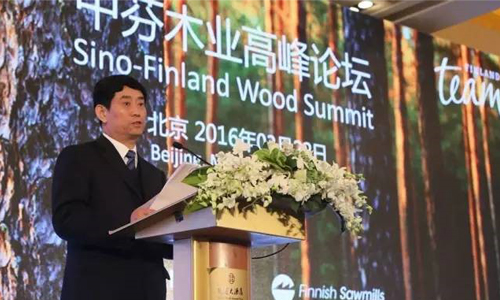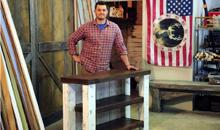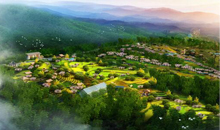Evolution of Lightweight Wood Composites
Lightweight boards and beams in the wood-based construction and furniture industry are not a new topic. Today, many ways to attain a lighter wooden structure are on offer, partially in industrial application. By Marius C Barbu, Transilvania University of Braşov
In the last decades, the development of lightweight wooden structure followed different patterns for core density reduction. The panels industry reduced the density for plywood (PY), particleboard (PB) and medium density fibreboard (MDF) using light available wood species, increased resination and optimised board density profiles.

This strategy was established as an industrial technique since the early 90s. This approach allows a reduction by one third of the initial density and keeps the main properties like internal bond (IB) and bending strength (MOR) in an acceptable range. f
The production costs could be a problem for manufacturers who do not have any light species available or no facilities to produce their own resin, because of their over 50 percent increased resination. The costs for material make up more than 50 percent of the total manufacturing costs. These light panels are thicker than 20mm and reach densities of 500kg/cubic metres but their fields of application became limited especially in the furniture industry.
The beams industry is using machine graded timber. Glue laminated timber (GLT) is regulated by norms in the use of light species due to their strength and gluability aspects. Due to this aspect the development has been oriented on specially designed I-beams made from machine graded squared timber or newly laminated veneer lumber (LVL) for the straps and PY, PB and oriented strandboards (OSB) for the web.
On the one hand, such beams reduce the weight by half but induce severe limitation of the spans and on the other hand increase the number of elements by the reduction of interspaces between the beams.
In the furniture industry, the booming development of MDF in the last two decades especially in Europe and later in Asia has stopped despite its excellent properties and processability. One possible reason is the high quality of raw materials, increased weight and implicitly their higher price.
PB continues to occupy the first place in terms of the global market (Europe and North America), sharing it again in the last few years with the PY (Asia).
Main advantages of PB compared to MDF or PY that can explain this situation are the possibility to use 100 percent recycled wood, to produce low weight panels at a low price compared to the other types. PY from light-weight fast growing species is in some regions a balanced solution between lower density and performances for building and furniture.
Generally, the large capacities in the furniture industry own processing and finishing technologies, which are limited only to PB and this might also be a reason for its supremacy. The European furniture industry (including Russia and Turkey) processes 54 percent of PB (38 million cubic metres) and 30 percent of the MDF (13 million cubic metres) world production.
Light Weight Designs
The high densities of the last panel type cause high end product weights. Only in recent years, lightweight design has become its own, independent subject that aims at improving functionality, reducing cost and ecological impact. Especially the fast-growing market for knockdown furniture demands low density structures.
New considerations imposed by take-away furniture chains limited the package weight in order to meet dimensions that match the ergonomic abilities for the end-users. Heavy pieces of furniture have to be split into more than one package. A maximum weight of 25kg per unit seems tolerable in this context.
However, by decreasing the weight of the individual pieces of furniture, handling can be also simplified once the product is assembled. This reduces the risk of damages and could extend the service life of the product.
Manufacturers of wooden prefab elements for construction witnessed favourable growth in Europe and US, and quite considerable growth in the Far East, at least until the start of the financial crisis of 1997 in Japan, followed by the worldwide crisis in 2008. The lowest point of the effect of the financial crisis on the building industry seems to have been overcome.
The unexpected rise in the price of steel now permits wooden construction systems to compete with the classic systems made of concrete and steel.
Finger-jointed timber has an important share in wooden building materials in Central Europe, especially in the Alps (2.6 million cubic metres) and are considered light due to the softwood used. GLT totalled 5 million cubic metresover Europe (about 3 million cubic metres), Asia (about 2 million cubic metres) and very low in North America and mostly made also from light soft wood (20mm) could be substituted by lightweight panels.
The recent decrease in classical board prices (especially PY, PB and MDF) is still an impediment for a short-term market implementation of the modern lightweight boards, independent of their performances. However, classical wood-based panels (>25mm) like PY, PB and MDF (mainly known as LDF) with partially reduced weight (>450kg/cubic metre) represent a proved solution in terms of performance and low prices.
A particular solution was the extruded PB which fitted well in the market until the plastic foams were accepted. Densities of 275 to 435kg/cubic metre for thicknesses between 30 and 60mm are difficult to achieve with modern technologies.
Generally, the quality of veneer, particles and fibre is higher than those for regular boards and also the glue amount and sometimes quality are significantly increased. Mechanical properties of core are comparable with the standard ones but face properties in terms of density and roughness are lower.
This kind of board does not cover the thickness range <25mm well. The severe density reduction in the core using a mixture of wood and non-wood particles and a certain compensation of density profile for faces paved the way for today’s industrial production.
A new generation of light PB (also < 25mm) with cores made from expanded polystyrene (EPS) and wood particles made possible density of 200kg/cubic metre. The forming area of a PB line requested for this new type an EPS bobbles preparation.
A special hybrid of this is the SuperPan Star which consists of faces of fibre and a core from wood particles and EPS pressed at the same time using a special production line containing MDF and PB equipment. The use of EPS has also some shortcomings like the melting on cauls and press belts and supplementary VOC emissions during the hot pressing and also some recycling issues during burning or reuse to PB.
Chopped Popcorn As Material
A replica using chopped popcorn instead of EPS using the name Balance Board. About 30 percent of the core wooden particles can be replaced by popcorn which is granulated at the production site. This light PB (P2) has an improved environmental impact but in longer contact with humidity or water fungi and insects attack is easier and the thickness swelling could be increased.
The idea of extruded PB was rethought in a dual density PB called BoBoard. The density of a 19mm PB varies in the width from less than 500kg/cubic metre to over 600kg/cubic metre. The higher density areas are pre-designed as place and width for the connectors,ie: between the shelves and side-walls of a bookcase.
For the Billy-bookcase, Ikea reported 16 percent materials savings using the BoBoard. The challenge for the production line is to supplement the forming area with mobile forming heads which have their own special dosage control. Also for the production planning of each order are requested the precise predesigned furniture part dimensions.
The latest generation of this kind of board is CoLight produced by Ikea Industry. This has a constant density (400kg/cubic metre) over the board width but uses pMDI glued flakes (40x40mm) allowing a weight reduction of 30 percent.
Also non-wood raw materials generated from agriculture like cereals or fibre plants straw (flax, hemp, kenaf) were used for decades to reduce the weight of PB due to their reinforcement effect.
Industrially produced PB with the name ‘Cannabis excellent’, Stropoly, Linex-Pro-Grass had densities between 350 and 550kg/cubic metre at thicknesses of 16 to 50mm. Further decades of research at lab scale using pMDI is dedicated to the use of other agro-residues like bagasse, bamboo, brassica, cork, corn, cotton, nut shells, etc.
Multilayered massive panels using extremely light species like albizia, balsa, ceiba, fuma andilomba have been produced for the door and furniture industry for many decades under trade names like Lightwood, ‘Sandwich light’ and ‘Ilomba light’.
The core density of those is 200 to 360kg/cubic metre for thicknesses between 16 to 22mm (balsa also 25 to 100mm). The faces are from thin lamellae or thicker veneer made from pine, poplar, lime or okoumé. The continuous importation of these wood species at an acceptable quality and price and the processing using appropriate glue system continue to be a challenge for the producers.
Cushioning Core
A new idea began more ten years ago primary to make lighter and more cushioning core for skis. This idea evolved into single-layer cores used for furniture and multilayer DendroLight panels also for light construction (floor, ceiling and wall).
This highly engineered timber product is manufactured in a multiple profiling, cross-laminating and band-sawing process. The key advantages of these panels are 40 percent lower weight, higher dimensional stability (0.5 percent swelling) and screw withdrawal.
The thicker panels used for building systems have good thermal, sound insulation and fire resistance. The initial weaknesses of this development about the laborious milling and sawing of lamellae and the 40 percent volume of resulting saw residues were solved with the first industrial production at DendrolightLatvija.
Some furniture design developments in the last three decades like thin elements, straight or curved surfaces, local joints and the use of melaminated paper or veneer-coated surfaces allow and require the use of lightweight wood-based panels. Some lightweight sandwich panel producers using classical discontinuous processes could not easily penetrate all possible application fields because of this situation.
A sandwich panel generally comprises three layers. The core, a comparatively thick layer, separates two thin surface layers, or facings. The main function of the core is to keep the facings at a certain distance. The core only bears lower shear stresses and thus can be very light.
The compression and tension stresses are highest in the facings, thus the facing structure has to be very strong. This provides very good static properties with respect to weight. The established technology for producing honeycomb sandwich panels with frames (board on frame (BOF); board on stiles (BOS)) and thin faces was optimised and reused recently to reduce weight by up to 50 percent.
Limitations Of Honeycomb Sandwiches
Some shortcomings of the honeycomb sandwiches still pose limitations for market success: sizes, fix frame position in the panel, low resistance to parallel loads, moisture resistance of cores and limitation for thinner boards (24mm).
One solution is the use of sandwich panels with a foam core which are produced in discontinuous processes use pre-expanded foams for the core and thin boards or foils for the facings. The core material is usually foamed and then sliced from a block to the desired thickness. The slices are glued on, prefabricated and coated with thick veneers, thin PY, PB or MDF.
In consequence, three individual steps are necessary to produce a foam-core sandwich panel. By using this technique, however, it is recommended to use finished coated facings, because the facings cannot be further processed in a continuous industrial manner because of their fixed dimensions.
As cell size of the foamed material is very small compared to tubes or honeycombs, problems with the heterogeneity of the core, like edge-processing or the ‘telegraphing’ effect on the surface are negligible. Moreover, foam cores often introduce thermal, acoustic insulation and sometimes fire retardant properties.
The high production costs caused by the discontinuous batch process and limited sizes counterbalance the important weight reduction that is possible using this technique. For standard thicknesses from 15 to 19mm, foam core panels can present a competitive alternative.
Continuous processes are used when it comes to materials that can be fed into a processing unit in a virtually endless manner, like from a coil. Compared to the discontinuous process, this technique uses fewer individual steps for the assembly of sandwich panels. Here, only prefabricated facings like foils or melamine impregnated papers are used, while the core is in most cases foamed between the facing during the production process.
Due to the adhesion properties of the foam—usually polyurethane (PU) foams are employed—no additional gluing layer is needed. This technique is preferable not only from an economic point of view, because the output is higher and the input of labour and material is lower. In addition, quality aspects reveal that a continuous manufacture generates more stable panel conditions and more diverse sizes.
Continuous Form Core Production
At Hamburg University, a novel approach for the continuous production of foam core sandwich panels with wood-based facings was patented. In this approach, the manufacture of the facings and the core takes place during the continuous hot pressing of the sandwich panel. The approach is derived from the conventional continuous production technique of wood-based panels (PB and MDF).
A three-layered mat composed of as yet not compacted resinated wood fibres or fine particles, coarse particles in the core, is formed using the forming heads like in the PB industry. In the core, there is also dry expandable thermoplastic material, which is triggered by temperature.
After the compaction of the facings at the designed higher density, the temperature in the core initiates an expansion. Shortly after, the press is opened to the desired panel thickness. After a consolidation phase (cooling), the panel is ready for cut-to-sizing. The overall density can be adjusted from 200 to 600kg/cubic metre.
As the polymer was mixed with wood particles in the core to optimise the scattering behaviour, a transition zone between the surface layers and the foam core is form-fitting. The bonding is defined by the adhesion quality of the polymer.
Also rigid foams made of lignin-furan or tannin-based condensation polymers mixed with wood fibres could be used in the same in situ process for the generation of the cores.
The use of special 3D skeletons in sandwich structures, such as corrugated cardboard or fibre-plastic prepregs is developing fast. Lisocore is industrially used as a light stable sandwich (270kg/cubic metre for 19mm) using thin wooden panel faces and a 3D (similar to an egg box) embossed kenaf or hemp fiber (80 percent) acryl matrix (20 percent) of Lightweight Solutions.
However until now, no technology could produce such engineered structures in a full core (without spacing) in a single pressing process. A new technology of Dascanova can produce at lab scale in situ by injection of water/steam a 3D structure designed with higher density into the core of a fibreboard (similar to MDF), which is connecting the faces to a strong load bearing light structure.
The European market needed about two decades to accept that social and demographic development no longer requires flats or houses and furniture for many generations.
Wooden houses are sufficient for one expected life span, acoustic and heat (summer-winter) insulations are acceptable, weatherability and fire proofness increased and the Eurocodes allows multi-storey timber construction.
Light-weight furniture is certainly not comparable to the solid one but the quality in terms of service is similar. Dimensional and moisture stability are acceptable despite the shorter life duration in use and reduced move cycles due to lower demountability.
Different techniques to save weight in the wood industry show individual downsides. Either the production of lightweight panels is too laborious, which in many cases means too costly, or the mechanical and physical performances of the panels are significantly decreased. With a growing number of benefits that lightweight structures are supposed to deliver, ie: decreasing weight and material costs and an increasing flexibility, the challenges increase. One way of saving weight is the general reduction of raw material and adjusted gluing systems and an increased resination; another way is the breakup of the structure.
Lightweight design as its own discipline contributes several concepts in this context, like the structural advantages of sandwich layouts with foams or honeycomb like cores. New one-stage processes were developed and tested up to pilot trials in order to improve the efficiency and to produce light sandwich structure industrially.
Against the background of a growing freedom in design for structure and furniture manufacturers and the need for efficient continuous production techniques, some of the presented developments should be soon an alternative for production techniques.(fdmasia)





 沪公网安备31010402003309号
沪公网安备31010402003309号



